These TS 10th Class Biology Bits with Answers 8th Lesson Heredity and Evolution will help students to enhance their time management skills.
TS 10th Class Biology Bits 10th Lesson Natural Resources
Choose the correct answer.
Question 1.
Decrease in ground water level is due to ……………..
A) lack of rainfall
B) deforestation
C) increase in number of borewells
D) all of these
Answer:
D) all of these
![]()
Question 2.
The chief function of IUCN ……………
A) To protect wild life habitats
B) To work on dry land agriculture
C) To study on viral diseases
D) To work on wet land agriculture
Answer:
A) To protect wild life habitats
Question 3.
Sustainable development means ………………
A) Prevention of wastage
B) Stable growth
C) Development without damaging
D) High production in less time
Answer:
C) Development without damaging
![]()
Question 4.
In order to increase the ground-water, the method to be adopted is …..
A) Digging more borewells
B) Deforestation
C) Urbanisation
D) Digging water harvesting pits
Answer:
D) Digging water harvesting pits
Question 5.
The reason for farmers growing Gliricidia is ……..
A) for decreasing pollution
B) to make the soil nitrogen rich
C) to control weeds
D) as fodder for cattle
Answer:
C) to control weeds
Question 6.
Identify the correct sentence regarding ecological pyramids.
A) In number pyramid, producers are always on top.
B) Charles Elton first introduced the shape of the ecological pyramids.
C) Generally number pyramid resembles Biomass pyramid.
D) From one trophic level to another trophic level energy flows without any loss.
Answer:
B) Charles Elton first introduced the shape of the ecological pyramids.
Question 7.
These are the earthen dams with masonry structures where water may overflow.
A) percolation tank
B) broad bed furrow
C) contour bunding
D) none of these
Answer:
A) percolation tank
![]()
Question 8.
Surface water in lakes, swamps and rivers is about……. % in total water on earth.
A) 97%
B) 1.75 – 2%
C) 0.01%
D) 0.7 – 0.8%
Answer:
B) 1.75 – 2%
Question 9.
Nearly two thirds of the available fresh water is in …………
A) seas, oceans
B) glaciers, ice & snow
C) ground water & soil moisture
D) lakes, swamps and rivers
Answer:
B) glaciers, ice & snow
Question 10.
Drip irrigation can reduce water consumption by ………
A) 50%
B) 20%
C) 2%
D) 70%
Answer:
D) 70%
![]()
Question 11.
Planting Gliricidia on field bands make the soil ……..
A) Nitrogen rich
B) Phosphorous rich
C) Potassium rich
D) Oxygen rich
Answer:
A) Nitrogen rich
Question 12.
These plants grow in estuaries respire with roots. [ ]
A) Seedless plants
B) Mangrove plants
C) Gllricidia plants
D) Monocot plants
Answer:
B) Mangrove plants
Question 13.
The continent that does not have forests
A) Asia
B) Africa
C) America
D) Antarctica
Answer:
D) Antarctica
Question 14.
Each year the earth loses about acres of forest. [ ]
A) 5 million
B) 50 million
C) 3 million
D) 36 million
Answer:
D) 36 million
Question 15.
Bishnoi’s belongs to this state. [ ]
A) Andhra Pradesh
B) Arunachal Pradesh
C) Rajasthan
D) Gujarat
Answer:
C) Rajasthan
Question 16.
Several crops are planted in alternating strips across a slope in [ ]
A) Dry land forming
B) Wet land forming
C) Alternative Crop
D) Contour strip forming
Answer:
D) Contour strip forming
Question 17.
Removing individual plants or small group of plants leaves other plants standing to anchor the soil is called [ ]
A) Seasonal harvesting
B) Selective harvesting
C) Rabi harvesting
D) Kharif harvesting
Answer:
B) Selective harvesting
![]()
Question 18.
……………. is the variety of living things that populate the Earth.
A) flora
B) Fauna
C) Biodiversity
D) None of these
Answer:
C) Biodiversity
Question 19.
Scientists estimate that the current rate of extinction is times the natural rate.
A) 10
B) 100
C) 1,000
D) 10,000
Answer:
C) 1,000
Question 20.
Which of the following are not made from petroleum?
A) Nylon
B) Plastic
C) Cosmetics
D) None of these
Answer:
D) None of these
Question 21.
This is best mean of transport for shorter distances. [ ]
A) Walk
B) Bike
C) Car
D) Public transport
Answer:
A) Walk
![]()
Question 22.
This is best mean of transport for long distances.
A) Walk
B) Bike
C) Car
D) Public transport
Answer:
D) Public transport
Question 23.
IUCN was founded in [ ]
A) 1980
B) 1948
C) 1950
D) 2011
Answer:
B) 1948
Question 24.
IUCN proposed a world conservation strategy in [ ]
A) 1984
B) 1948
C) 1978
D) 1960
Answer:
A) 1984
Question 25.
Which of the following is not a sustainable forestry method?
A) Low impact logging practices
B) Harvesting with natural regeneration in mind
C) Removing all the high-value trees from a forest
D) All the above
Answer:
C) Removing all the high-value trees from a forest
Question 26.
Bamboo is actually a type of [ ]
A) wood
B) grass
C) root
D) none of these
Answer:
D) none of these
![]()
Question 27.
Which of the following is a renewable resource?
A) Coal
B) Biodiversity
C) Petroleum
D) Natural gas
Answer:
B) Biodiversity
Question 28.
Which of the following is a non-renewable resource?
A) Air
B) Water
C) Minerals
D) Soil
Answer:
C) Minerals
Question 29.
Plants used for production of biofuel are [ ]
A) Pongamia glabra
B) Jatropa curcas
C) Acacia melanoxylon
D) Azadirachta Indica
Answer:
B) Jatropa curcas
Question 30.
Biodiversity is Important for more than Just food and for [ ]
A) Medicines
B) Firewood
C) Wood
D) All the above
Answer:
A) Medicines
![]()
Question 31.
Example for non-renewable resource is ……
A) Coal
B) Petroleum
C) Natural gas
D) All the above
Answer:
D) All the above
Question 32.
Which is the alternative method to prevent groundwater depletion?
A) Recharge structures
B) Water sheds
C) Percolation pits
D) All the above
Answer:
D) All the above
Question 33.
cultivation of paddy is suitable for growing in these areas
A) Water scarcity areas
B) No water scarcity areas
C) Low-temperature areas
D) Sandy soiled areas
Answer:
B) No water scarcity areas
Question 34.
These are earthen dams with masonry structures where water may overflow [ ]
A) Percolation tanks
B) Reservoirs
C) Ponds
D) All the above
Answer:
A) Percolation tanks
![]()
Question 35.
Out of all the water on Earth, salt water in oceans, seas and saline ground water make up about % of it. [ ]
A) 7
B) 97
C) 96
D) 95
Answer:
B) 97
Question 36.
Planting these trees on field blinds make the soil nitrogen rich [ ]
A) Aloevera
B) Gliricidia
C) Ipotnea
D) Elchornia
Answer:
B) Gliricidia
Question 37.
The percentage of cultivable land around the world is irrigated by drip irrigation [ ]
A) 3%
B) 4%
C) 2%
D) 5%
Answer:
C) 2%
Question 38.
Read the following sentences.
1) Digging contour field hunding horizontally
2) Gliricidia plants store nitrogen in soil
3) Crop yield is measured in T.M.c.
4) Supply of water by sprinkler is called micro irrigation
What are correct sentences mention above?
A) 1, 2, 3
B) 2, 3, 4
C) 1, 3, 4
D) 1, 2, 4
Answer:
D) 1, 2, 4
Question 39.
Required amount of water for irrigation by 2025 is …….. [ ]
A) 3418 TMC
B) 3814 TMC
C) 3989 TMC
D) 3899 TMC
Answer:
B) 3814 TMC
Question 40.
Resources that can be replaced after they are used are called [ ]
A) Renewable resources
B) Non renewable resources
C) Non conventional energy resources
D) None of the above
Answer:
A) Renewable resources
![]()
Question 41.
Examples for a renewable resources are [ ]
A) Air, water, plants
B) Air, water, animals
C) Air, water, soil, plants
D) Air, water, coal, plants
Answer:
C) Air, water, soil, plants
Question 42.
Identify the non-renewable resource.
A) Solar energy
B) Nuclear energy
C) Petroleum
D) Biodiversity
Answer:
C) Petroleum
Question 43.
The resources that cannot be replaced at all are called [ ]
A) Non-renewable resource
B) Renewable resource
C) Conventional energy
D) None of the above
Answer:
A) Non-renewable resource
Question 44
Through which people can reduce waste and manage natural resources wisely [ ]
A) Expenditure of sources
B) Indiscriminate use of sources
C) Conservation
D) Not preserving sources
Answer:
C) Conservation
Question 45.
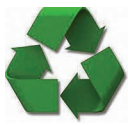 This logo shows [ ]
This logo shows [ ]
A) Reuse
B) Red tice
C) Recover
D) Recycle
Answer:
D) Recycle
Question 46.
Forests serve as for the world.
A) Heart
B) Parks
C) Lungs
D) Plains
Answer:
D) Plains
Question 47.
Each year the amount of forest land we are loosing [ ]
A) 26 million acres
B) 36 million acres
C) 33 million acres
D) 25 million acres
Answer:
B) 36 million acres
![]()
Question 48.
Soil erosion occurs due to [ ]
A) Deforestation
B) Floods
C) Overgrazing
D) All the above
Answer:
D) All the above
Question 49.
Deforestation accounts for how much percent of the world’s greenhouse gas emissions? [ ]
A) 15%
B) 16%
C) 17%
D) 18%
Answer:
A) 15%
Question 50.
Plant conservation and animal conservation depends on [ ]
A) Water conservation
B) Soil conservation
C) Nutrients conservation
D) Atmosphere conservation
Answer:
B) Soil conservation
Question 51.
Soil erosion can be prevented by [ ]
A) Contour strip cropping
B Growing grass
C) Planting trees on bunds
D) All the above
Answer:
D) All the above
Question 52.
The practice of removing individual plants or small group of plants leaves, other plants standing to anchor the soil is called [ ]
A) Hand picking
B) Weeding
C) Selective Harvesting
D) Harvesting
Answer:
C) Selective Harvesting
Question 53.
It is the variety of living things that populate the earth [ ]
A) Bioaccumulation
B) Biomagnification
C) Biosphere
D) Biodiversity
Answer:
D) Biodiversity
Question 54.
World wide, number of plant species using for medicinal purpose [ ]
A) 60,000 to 70,000
B) 50,000 to 70,000
C) 40,000 to 60,000
D) 70,000 to 80,000
Answer:
B) 50,000 to 70,000
![]()
Question 55.
Fossil fuels were produced from the remain of [ ]
A) Plants
B) Animals
C) Plants and animals
D) Renewable sources
Answer:
C) Plants and animals
Question 56.
Nearly one-third of the Iron produced come from recycled automobiles in this country [ ]
A) America
B) Germany
C) Japan
D) China
Answer:
A) America
Question 57.
A project of the centre for World Solidarity (Secunderabad, is) helped the farmers of Vaddicherla and Vana par-thy in [ ]
A) Digging the borewells
B) Constructing percolation tanks
C) Recharging borewells
D) Digging the wells to a greater depth
Answer:
C) Recharging borewells
Question 58.
Farmers were provided technical support for cost efficient water storage and soil conservation structures by [ ]
A) ICAR
B) IARI
C) ICRISAT
D) IRRI
Answer:
C) ICRISAT
Question 59.
Sri Ram Sugar project was constructed on the river in Telangana region.
A) Godavari
B) Krishna
C) Manjeera
D) Nagavali
Answer:
A) Godavari
Question 60.
Restrictions on water use are being implemented in this country on a large scale [ ]
A) Newzealand
B) Australia
C) Brazil
D) Venezuela
Answer:
B) Australia
Question 61.
Which can co-exist in harmony? [ ]
A) Development and Conservation
B) Development and Industrialisation
C) Human Resource and Industrialisation
D) Conservation and Preservation
Answer:
A) Development and Conservation
Question 62.
Sustainable development is [ ]
A) Using resources for present use
B) Preserving resources for future use
C) Indiscriminate use of resources
D) Destroying the environment for development
Answer:
B) Preserving resources for future use
![]()
Question 63.
Mountain top removal mining (MTR), devastate [ ]
A) Environment
B) Biosphere
C) Lithosphere
D) Hydrosphere
Answer:
A) Environment
Question 64.
“All forms of life – human, animal and plant are so closely interlinked that disturbance of one gives rise to imbalance in the other’ who said these words?
A) Mahatma Gandhi
B) Jawaharlal Nehru
C) Indira Gandhi
D) Lai Bahadur Sastry
Answer:
C) Indira Gandhi
Question 65.
The four R’s to save the environment [ ]
A) Reduce, Reuse, Recycle, Recover
B) Recover, Reuse. Recycle, Reduce
C) Reduce, Recover, Recycle. Reuse
D) Reduce. Reuse, Recover, Recycle
Answer:
A) Reduce, Reuse, Recycle, Recover
Question 66.
The international union for conservation of nature (IUNC) works to protect ( )
A) Wild life
B) Habitats
C) Ecosystems
D) Wild life. Habitats
Answer:
D) Wild life. Habitats
Question 67.
Ozone layer is damaged by [ ]
A) carbon dioxide
B) oxygen
C) chlorofluorocarbons
D) nitrogen dioxide
Answer:
C) chlorofluorocarbons
Question 68.
Example for bio fuel is. [ ]
A) Coal
B) Petroleum
C) Jatropa
D) Kerosene
Answer:
C) Jatropa
Question 69.
In the above pie diagram, sources vs area under irrigation is should. The ground water percentage is ……………… [ ]
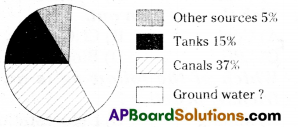
A) 40%
B) 45%
C) 43%
D) 48
Answer:
C) 43%
![]()
Question 70.
It’s a non-renewa bic resource [ ]
A) Water
B) Solar energy
C) Coal
D) Soil
Answer:
C) Coal
Question 71.
If deforestation is done in large scale, I this natural calamity may occur.
A Volcanic eruption
B) Earthquakes
C) Global warming
D) Tsunamis
Answer:
C) Global warming
Question 72.
This is not a method of saving fuel …………
A) Using bicycle :
B) Travel in trains instead of cars
C) Using celiphones
D) Drawing of water from wells
Answer:
B) Travel in trains instead of cars
Question 73.
The particulate pollutant that pollutes air [ ]
A) CO
B) ash
C) SO2
D) CO
Answer:
B) ash
Question 74.
The Recycle logo instructs us [ ]
A) Item can be recycled after use
B) items can be thrown away after use
C) Items can be, burnt after use
D) None of the above
Answer:
A) Item can be recycled after use
![]()
Question 75.
Percolation tanks are constructed
A) to store water for future use
B) where water may overflow
C) to grow fish and prawn
D) all the above
Answer:
B) where water may overflow
Question 76.
The average fall of ground water in Telangana during 1998-2002 [ ]
A) 2 meters
B) 4 meters
C) 3 meters
D) 5 meters
Answer:
C) 3 meters
Question 77.
Example for micro irrigation techniques
A) Drip irrigation
B) Sprinkler
C) Canals
D) A & B
Answer:
D) A & B
Question 78.
The crop grown in Rabi season [ ]
A) Wheat
B) Paddy
C) Maize
D) Cotton
Answer:
A) Wheat
Question 79.
Reo solas kir over-exploitation and depletion of ground water resources
A) indiscriminate tapping of ground water by too much drilling
B) Construction of deep tube wells
C) Construction of bore wells
D) All the above
Answer:
D) All the above
Question 80.
Soak pits help [ ]
A) to store water
B) to recharge dried-up bore wells
C) water facility or animals
D) to keep soil moist
Answer:
B) to recharge dried up bore wells
![]()
Question 81.
Root systems of plants help in [ ]
A) Soil becomes unfertile
B) Soil becomes dry
C) Soil conservation
D) Soil erosion
Answer:
C) Soil conservation
Question 82.
The number of dry open wells recharged by Sri Ram Sagar Project was [ ]
A) 25
B) 26
C) 27
D) 2
Answer:
D) 2
Question 83.
The lifeline for a large part of telangana is [ ]
A) Polavar am Project
B) lialeru Nagara Project
C) Sri Ram Sagar Project
D) Hirakud Project
Answer:
C) Sri Ram Sagar Project
Question 84.
The Major rivers in Telangana & Andhra Pradesh are ……..
A) Godavar and Krishna
B) Kristna and Kaveri
C) Godavari and Vamsadhara
D) Perrna and Kaveri
Answer:
A) Godavar and Krishna
Question 85.
Earth natural resources ……….
A) Air, water, Soil
B) Minerals, fuels
C) Plants and animals
D) All the above
Answer:
D) All the above
Question 86.
Conservation is the practice off ………….
A) using natural resources freely
B) Caring for natural resources
C) Sending to other states
D None of the above
Answer:
B) Caring for natural resources
![]()
Question 87.
The percentage at the water in ground …………..
A) 40%
B) 42%
C) 43%
D) 44%
Answer:
C) 43%
Question 88.
The plants planted along the roads, field bunds and nalas are [ ]
A) Saplings of useful species
B) Neern. mango
C) Eucalyptus
D) All the above
Answer:
A) Saplings of useful species
Question 89.
The country that recycles many raw materials used in a king automobile is [ ]
A) China
B) Japan
C) India
D) Amerka
Answer:
B) Japan
Question 90.
The country which produces iron from recycled automobiles [ ]
A) Japan
B) India
C) United States
D) None of the above
Answer:
C) United States
Question 91.
Wildlife habitats are destroyed due to [ ]
A) Deforestation
B) Global warming
C) El Nino
D) All the above
Answer:
D) All the above
Question 92.
By using broad bed furrows and micro irrigation techniques, farmers obtained [ ]
A) 250 kg more pigeon pea per hectare
B) 50 kg more maize per hectare
C) 300 kg more rice per hectare
D) Both A and B
Answer:
D) Both A and B
Question 93.
Match the following.
List-A —- List-B
1. Mulching ( ) a) Eco-friendly method
2 Public transport ( ) b) Dry land irrigation
3. Drip irrigation ( ) c) Soil convervation
A) 1 – c, 2 – b, 3 – a
B) 1 – a, 2 – b, 3 – c
C) 1 – b, 2 – a, 3 – c
D) 1 – c, 2 – a, 3 – b
Answer:
D) 1 – c, 2 – a, 3 – b
![]()
Question 94.
Arrange the flow chart in the correct order. [ ]

A) 1, 4, 3, 5, 2
B) 2, 5, 4, 3, 1
C) 2, 4, 1, 5, 3
D) 2, 1, 4, 3, 5
Answer:
D) 2, 1, 4, 3, 5
Question 95.
KG. Basin :Petroleum & aturalgas :: Gliricidia : …………
A) Avenue plant
B) Fruit yielding
C) Ornamental
D) N2 fixation
Answer:
D) N2 fixation
Question 96.
Pick the odd mail-out. [ ]
A) Coal
B) CNG
C) LPG
D) Biogas
Answer:
D) Biogas
Question 97.
Which of the following is an eco-friendly practice? [ ]
A) Mining
B) Deforestation
C) Thermal lower plants
D) Wind power generation
Answer:
D) Wind power generation
Question 98.
Match the following. [ ]
1. Check darn ( ) a) Eco-friendly fuel
2. Multipurpose hydral project ( ) b) Water conservation
3. CNG ( ) c) Sri Ram Sagar
A) 1 – a, 2 – b, 3 – c
B) 1 – b, 2 – a, 3 – c
C) 1 – c, 2 – b, 3 – a
D) 1 – b -2 – c , 3 – a
Answer:
D) 1 – b -2 – c , 3 – a
![]()
Question 99.
Expand UNDP :
A) United Nations Development Plai
B) United Nations Development Programme
C) United Nations Drought Programme
D) United Nations Dropout Programme
Answer:
B) United Nations Development Programme
Question 100.
The practice shown in the given figure is used to conserve [ ]
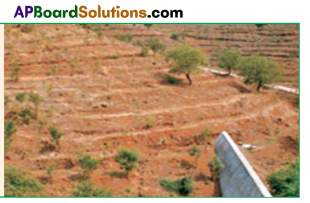
A) Ground water
B) Rain water
C) Run-off water
D) Soil
Answer:
D) Soil
Question 101.
In the given picture, the farmer is preparing the soil for broad bed furrows. This method is used for the

A) soil and water
B) fertilizer application
C) weeding operations
D) all the above
Answer:
D) all the above
![]()
Question 102.
Can you guess the use of this plantation on field bunds? [ ]
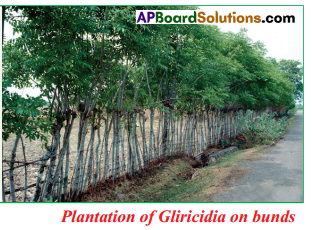
A) To strengthen the bunds
B) To make the soil nitrogen rich
C) To increase ground water
D) A and B
Answer:
D) A and B
Question 103.
Can you name this water harvesting structure? [ ]

A) Contour trench
B) Mini percolation pit
C) Rain hund
D) Community-based masonry darn
Answer:
D) Community-based masonry darn
![]()
Question 104.
This is the best method for the conservation or soil. Can you guess that ?
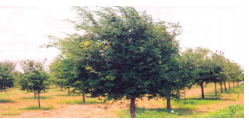
A) BBF method
B) Contour trenching
C) Tree plantation on waste land
D) Check clams construction
Answer:
C) Tree plantation on waste land
Question 105.
The major source of irrigation in A.P.
A) River Krishna
B) River Godavari
C) Tanks
D) Grourii water
Answer:
D) Grourii water
Question 106.
Khejri’ is associated with this tribe.
A) Chenchu
B) Koya
C) Savara
D) Bishnoi
Answer:
D) Bishnoi
Question 107.
Can you guess the use of this plant?

A) Medicinal plant
B) Commercial plant
C) Rare plant
D) Bio-fuel plant
Answer:
D) Bio-fuel plant
Question 108.
These seeds are used for the production of bio-fuel. From which plant we get these seeds? [ ]
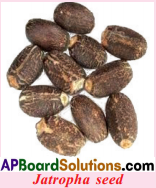
A) Coffee
B) Gliricidia
C) Custard apple
D) Jatropa
Answer:
D) Jatropa
![]()
Question 109.
This devastates the environment [ ]
A) Open-cast mining
B) Coal mining
C) Mountain top removal mining (MTR)
D) None
Answer:
C) Mountain top removal mining (MTR)
Question 110.
This is a tile bet example for [ ]

A) Recycle
B) Reuse
C) Reduce
D) Sustainable level development
Answer:
B) Reuse
Question 111.
This ‘logo’ indicates [ ]

A) Recycle
B) Reise
C) Reduce
D) Susunable development
Answer:
A) Recycle
![]()
Question 112.
The elite problem in the recycling of plastics lies in …………………
A) Sorting
B) Grading
C) Collection
D) Their complexity
Answer:
D) Their complexity
Question 113.
Can you identify the water harvesting structure? [ ]
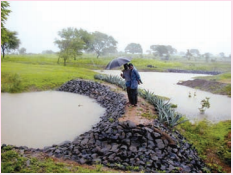
A) check dam
B) water soak pit
C) contour trench
D) percolation tank
Answer:
D) percolation tank
Question 114.
Identify the mismatched pair. [ ]
1) Biodiesel plant – Jatropa
2) Soil conservation – BBF
3) centre for world solidarity – Vijayawada
A) 1, 2
B) 2 only
C) 3 only
D) 1, 3
Answer:
C) 3 only
Question 115.
Match the following. [ ]
List – A —- List – B
1. ICRISAT ( ) a) Renewable energy source
2. Tidal power ( ) b) Non renewable energy source
3. Diesel ( ) c) Hyderabad
A) 1-a, 2-c, 3-b
B) 1-b, 2-c, 3-a
C) 1-a, 2-b, 3-c
D) 1-c, 2-a, 3-b
Answer:
D) 1-c, 2-a, 3-b
Question 116.
| Plant | Use |
| 1) Jatropa 2) Gliricidia |
bio-diesel ? |
A) Make the soil iron rich
B) Make the soil phosphorus rich
C) Make the soil nitrogen rich
D) Make the soil boron rich
Answer:
C) Make the soil nitrogen rich
Question 117.
Which of the following are not made from petroleum? [ ]
A) Nylon
B) Plastic
C) Cosmetics
D) None of the above
Answer:
D) None of the above
![]()
Question 118.
Match the following. [ ]
List-A —- List-B
1. Percentage of groundwater on earth ( ) a) Godavari
2. Sriram Sagar project ( ) b) CFCs
3. Ozone depletion ( ) c) 43%
A) 1 – c, 2 – b, 3 – a
B) 1 – a, 2 – b, 3 – c
C) 1 – b, 2 – a, 3 – c
D) 1 – c, 2 – a. 3 – b
Answer:
D) 1 – c, 2 – a. 3 – b
Question 119.
The country that recycles many raw-material used is making automobiles [ ]
A) India
B) USA
C) Russia
D) Japan
Answer:
D) Japan
Question 120.
IUCN work to protect [ ]
A) Wildlife
B) Habitats
C) Ecosystem
D) Wildlife habitats
Answer:
D) Wildlife habitats
Question 121.
Identify the in-is matched pair. [ ]
1) Bishnoi – Rajasthan
2) Deforestation – Global warming
3) MiR – Eco friendly
A) 1, 2
B) 2 only
C) 3 only
D) 1, 3
Answer:
C) 3 only
![]()
Question 122.
Jatropa : bio-fuel: : Khejri : …….?……… [ ]
A) Koya
B) Savara
C) Gondu
D) Bishnoi
Answer:
D) Bishnoi